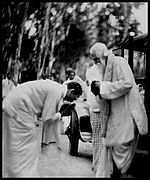Wilmot A. Perera
This article includes a list of references, related reading, or external links, but its sources remain unclear because it lacks inline citations. (April 2020) |
Wilmot A. Perera | |
|---|---|
 | |
| Ceylonese Ambassador to China | |
| In office 1957–1958 | |
| Preceded by | Claude Corea |
| Succeeded by | William Gopallawa |
| Member of Parliament for Matugama | |
| In office 20 September 1947 – 10 April 1956 | |
| Personal details | |
| Born | 1905 June 12 |
| Died | 1973 |
| Nationality | Sri Lankan |
| Political party | Viplavakari Lanka Sama Samaja Party |
| Other political affiliations | Lanka Sama Samaja Party |
| Spouse | Esme Perera Abeywardena |
| Relations | Grand Children: Deesala Peiris, Ishita Peiris, Shaminda Perera |
| Children | Enoka & Ajit |
| Residence | Horana |
| Alma mater | Royal College, Colombo |
| Occupation | Planter |
Wilmot Abraham Perera (1905–1973) was a Sri Lankan statesman and philanthropist. He was declared a National Hero in 1993. A member of parliament, he was Ceylon's first Ambassador to China.
Born in Panadura to M. Abraham Perera, a wealthy landowner, widely known as the "Rubber King", he was educated initially at St. John's College Panadura and later at the Royal College, Colombo. He was a grandson of Jeramias & Celestina Dias.
Taking over the family plantations, he became active in his home area, establishing the first rural development society in Raigam Korale. He went on to establish Sri Palee College in Horana, based on the Rabindranath Tagore's Shantiniketan in 1934. The foundation stone was laid by Tagore on 20 May 1934 on his last visit to Ceylon. The Sri Palee Trust was established by him to manage the lands gifted by him. After his death, part of this property comprising many buildings was donated to the University of Ceylon by his family, in his memory in 1976. This later became the Sri Palee Campus of the University of Colombo.
The Suriya-Mal Movement was inaugurated at his residence in 1933. In 1935 he became a founding member of the Lanka Sama Samaja Party, becoming active politics and the Sri Lankan independence movement he was elected to the first post independence parliament in 1947 as an Independent Socialist, defeating the "father of free education" C.W.W. Kannangara. He was also a member of the Viplavakari Lanka Sama Samaja Party for a short while. He was appointed as the 1st Ceylonese Ambassador to China in 1957 when Ceylon established diplomatic ties with the People's Republic of China. In 1961 he was appointed to head the 1st Salaries and Cadres Commission (known thereafter as the Wilmot A. Perera Commission). He also served as the Chairman of the Commission for Higher Education. After his death, his ancestral home in Panadura was handed over to the Sri Sumangala Girls' School. He was married to Esme Perera Abeywardena, a grand daughter of the late Sir Charles Henry de Soysa, Sri Lanka's foremost Philanthropist. They had two children, a daughter Enoka & son Ajit.
-
Wilmot A Perera greeting Rabindranath Tagore when he arrived to lay the foundation stone to Sri Palee, on 20 May 1934.
-
Wilmot A. Perera with Hon. S.W.R.D. Bandaranaike PM & Sir Swarvapali Radhakrishan, Pres. of India during a visit to Sri Palee
-
Wilmot A. Perera presenting his credentials to chairman Mao as Ceylon's 1st Ambassador
Bibliography
- Problems of Rural Ceylon (1932)



